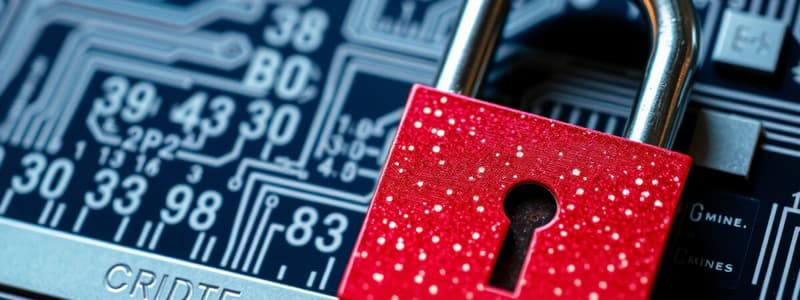Podcast
Questions and Answers
What is the primary difference between block ciphers and stream ciphers?
What is the primary difference between block ciphers and stream ciphers?
- Block ciphers encrypt data in fixed-size blocks. (correct)
- Stream ciphers require padding to complete the encryption process.
- Stream ciphers use a fixed block size for encryption.
- Block ciphers encrypt data one bit at a time.
Which of the following statements about XOR encryption is correct?
Which of the following statements about XOR encryption is correct?
- XOR is used to compare two bits and returns 1 if they are different. (correct)
- XOR is a method that consistently predicts the output based on the input.
- XOR returns 0 if the bits being compared are different.
- XOR can only be used for encrypting plaintext.
In the process of using a block cipher, what step is taken if the plaintext is shorter than the required block size?
In the process of using a block cipher, what step is taken if the plaintext is shorter than the required block size?
- The plaintext is split into two blocks.
- Padding is added to reach the block size. (correct)
- The encryption process is aborted.
- The plaintext is discarded.
Which key lengths are currently used in the Advanced Encryption Standard (AES)?
Which key lengths are currently used in the Advanced Encryption Standard (AES)?
What is the purpose of a key in block ciphers?
What is the purpose of a key in block ciphers?
Which of the following best describes the process of encryption in stream ciphers?
Which of the following best describes the process of encryption in stream ciphers?
What is the main characteristic of symmetric encryption?
What is the main characteristic of symmetric encryption?
Which encryption standard is characterized by repeating the encryption process three times with three different keys?
Which encryption standard is characterized by repeating the encryption process three times with three different keys?
What operation is used to combine the keystream with the plaintext bits in keystream generation?
What operation is used to combine the keystream with the plaintext bits in keystream generation?
Which encryption standard uses a key size of up to 448 bits?
Which encryption standard uses a key size of up to 448 bits?
What is a defining characteristic of asymmetric ciphers?
What is a defining characteristic of asymmetric ciphers?
Which of the following statements about digital signatures is correct?
Which of the following statements about digital signatures is correct?
In Pretty Good Privacy (PGP), what is created in Step 1?
In Pretty Good Privacy (PGP), what is created in Step 1?
What is the maximum block size supported by the RC5 block cipher?
What is the maximum block size supported by the RC5 block cipher?
What method does RSA use to link a public key to a private key?
What method does RSA use to link a public key to a private key?
Which symmetric cipher standard repeats the encryption process three times?
Which symmetric cipher standard repeats the encryption process three times?
Which characteristic is true for symmetric ciphers compared to asymmetric ciphers?
Which characteristic is true for symmetric ciphers compared to asymmetric ciphers?
What type of key does the recipient keep secret in an asymmetric cipher?
What type of key does the recipient keep secret in an asymmetric cipher?
Flashcards are hidden until you start studying
Study Notes
Cipher Classification
- Modern ciphers are categorized into block or stream types, and as symmetric or asymmetric.
- Ciphers operate on individual bits (1s and 0s), utilizing character encoding systems like ASCII.
Block Ciphers
- Plaintext is converted to binary before applying a binary key.
- Encrypted data is divided into blocks, commonly 64 bits for DES and 128, 192, or 256 bits for AES.
- Triple DES (3DES) processes the same plaintext three times with three different keys for enhanced security.
- Padding with 0s or 1s is added to plaintext to complete block size requirements.
- Keys are crucial for encrypting and decrypting the data.
Stream Ciphers
- Encrypt data one bit at a time, making them efficient for varying data lengths.
- Key characteristics include:
- Bit-by-Bit Encryption: Operates on a continuous stream of bits.
- Keystream Generation: Combines key bits with plaintext using XOR to produce ciphertext.
- Synchronization: Sender and receiver must use the same keystream.
- Efficiency: Faster than block ciphers, ideal for real-time applications.
Specific Cipher Examples
- Data Encryption Standard (DES): Utilizes a block and key size of 64 bits.
- Advanced Encryption Standard (AES): Offers block and key sizes of 128, 192, or 256 bits, improving resistance to brute-force attacks.
- Blowfish: A block cipher characterized by 64-bit blocks and variable key sizes from 32 to 448 bits, known for speed and simplicity.
- RC5: A versatile block cipher supporting block sizes of 32, 64, or 128 bits, and key sizes up to 2048 bits.
Symmetric vs. Asymmetric Ciphers
-
Symmetric Ciphers:
- Use the same secret key for both encryption and decryption.
- Faster and less computationally intensive compared to asymmetric ciphers.
-
Asymmetric Ciphers:
- Feature two keys: a public key for encryption and a private key for decryption.
- Keys are mathematically related but cannot derive one from the other.
- Enhanced security, making it nearly impossible to deduce the private key from the public key.
Practical Applications
- Pretty Good Privacy (PGP): A security protocol using both public and private keys for encrypted communications.
- A public key for encrypting messages, shared openly.
- A private key for decrypting messages, kept secret.
- Validates message authenticity through digital signatures.
RSA Encryption
- First public key encryption method, using large prime numbers for linking public and private keys.
- Can generate a hash code for message verification via MD5, ensuring message integrity.
Studying That Suits You
Use AI to generate personalized quizzes and flashcards to suit your learning preferences.




